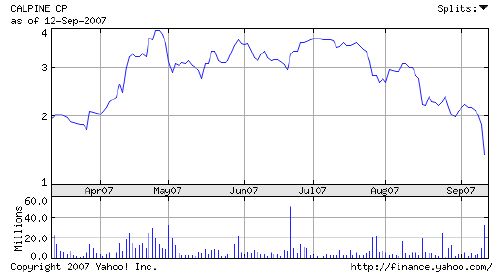Blog Archives
NGP reports Flow Test Results
Click for larger image

Via Yahoo News:
VANCOUVER, BRITISH COLUMBIA–(MARKET WIRE)–Sep 19, 2007 — Nevada Geothermal Power Inc. (“NGP”) (CDNX:NGP.V – News)(OTC BB:NGLPF.OB – News), today announced Well 23-14, completed to a depth of 3415 feet (1041 metres), intersected a geothermal production zone similar to that intersected in Well 26A-14.
GeothermEx, Inc. stated that the “…rig test has indicated that the well is a prolific producer.”
On September 15, 2007, Well 23-14 flowed geothermal fluid under its own pressure at a post flash rate of 1865 gallons/minute (118 litres/sec) and a well head pressure of 78 psig (538kPa). A static temperature survey on September 16, 2007 showed a maximum downhole temperature of 374 degreesF (190 degreesC). Preparations are underway for longer term testing with results expected in two weeks’ time.
Meanwhile, Well 38-14, which has been shut in for eight weeks, has heated up to a maximum temperature of 355 degrees F (179 degrees C) at a depth of 2657 feet (810 metres) and the shut in wellhead pressure has increased to 150 psi (1035 kPa). The results indicate that Well 38-14 may also have a connection with the reservoir intersected in Wells 26A-14 and 23-14. However, geothermal fluid flow is currently restricted. Further assessment of 38-14 is planned.
They’ve got heat, they’ve got pressure, and they’ve got flow. Congratulations Nevada Geothermal, you’re well along the way to making the power plant a reality.
Comments are off for this post
Geothermal Resources Council Annual Meeting Oct 1-3
The Geothermal Resources Council (GRC) will hold its annual meeting at John Ascauga’s Nugget October 1-3. There are multiple field trips and pre-meeting sessions offered in the days leading up to the meeting as well. The draft agenda is beefy and it’s clear that this is the event you want to attend if you’re the least bit interested in geothermal systems, both from an electricity production and direct use perspective.
Sign up at the GRC website if you’re interested in attending.
Calpine’s Market Cap Shrinks
Back in June when Calpine’s reorganization plan was announced, the stock traded at $2.93 per share. On that day, we predicted that the shares would slide (in the face of a post-announcement pop to $3.21/share) to a level that would more accurately reflect the value for shareholders.

Yesterday, the issue closed at $1.39/share. It has traded as high as $1.55/share today.
Does this mean Calpine is a bad company? No, not at all. It does mean that the reorganization plan and the company’s desire to “go it alone” leave investors with limited near-term upside. On the contrary, if Calpine invests in expansion of the geothermal portfolio and slims its fossil fuel portfolio to profitable plants, this is potentially a good long-term investment – particularly now that the shares are trading at a level closer to intrinsic value.
Where do the shares go from here? It depends on the execution of the reorganization plan, natural gas prices, and non-fossil fuel generation investment decisions. If these work out favorably, there should be a nice appreciation. If any of the 3 are out of line, expect the issue to stay flat or even fall a little further. Caveat Emptor.
The principals of MeV hold no position in Calpine. Comments are off for this post
Cree’s SAM electric vehicle

The Creative Engineering Company (Cree) in Switzerland is back with a reconstituted SMART car called SAM. This two passenger car has a range of over 50km, can cruise at 85kph, and gets a full charge within 6 hours (70% in 2 hours.) The vehicle has a target price of $9,125. There are 80 of these vehicles plying the roads of Switzerland right now. It’s an unique vehicle with a two seat, front/back configuration – kind of like a fighter plane. Long road trips are out of the question, but that usual bopping around town activity can easily be covered with the SAM. Comments are off for this post
How to assess geothermal resource potential
Question: I live near a geothermal hot spring. Does that mean that there are geothermal power resources underground? How do I go about finding out? — John from Moscow, Idaho
Karl Gawell’s Answer: Hi John. Thanks for your inquiry. I wish I could take a look at the spring. I came across one on a mesa just off a bike trail in the desert in New Mexico, and it was quite a beautiful sight. There was boiling water on the surface and all kinds of mineral deposits in and around the spring with patches of different colors.
The best answer I can give you to the first part of your question is a definite maybe. I would say that the chances are pretty good that you live near a geothermal resource. However, whether or not it is a resource that could be used for electrical power would require further exploration.
For a geothermal power resource you really need three things: 1. Hot water (do you happen to know the temperature of the spring?) 2. Permeability in the rock, and 3. Both of these attributes at a depth that is economically reachable.
There are a great many things one can do to assess resource potential including magnetic surveys, aerial photography, shallow temperature gradient grids (2m), fault mapping, and geothermal chemistry analysis (on springs like the one listed above.) Once the results from these activities are known, it may be worthwhile to invest in temperature gradient well(s) and if that checks out, you might move on to attempt to drill production wells. Geothermal resources have all the risk of petrochemical exploration and hopefully, as awareness and pricing adjust to meet the current state of power production, the reward will be similar as well. Until the reward more closely matches the risk, geothermal exploration and development will be hampered by lack of funding, particularly in the early stages of exploration and drilling.
Comments are off for this post








